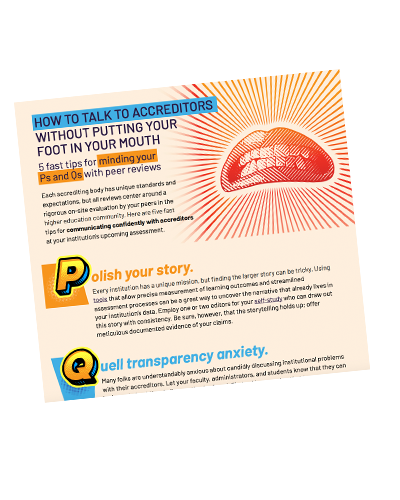 Each accrediting body has unique standards and expectations, but all reviews center around a rigorous on-site evaluation by your peers in the higher education community. Here are five fast tips for communicating confidently with accreditors at your institution’s upcoming assessment.
Each accrediting body has unique standards and expectations, but all reviews center around a rigorous on-site evaluation by your peers in the higher education community. Here are five fast tips for communicating confidently with accreditors at your institution’s upcoming assessment.


 Polish your story.
Polish your story.Every institution has a unique mission, but finding the larger story can be tricky. Using tools that allow precise measurement of learning outcomes and streamlined assessment processes can be a great way to uncover the narrative that already lives in your institution’s data. Employ one or two editors for your self-study who can draw out this story with consistency. Be sure, however, that the storytelling holds up; offer meticulous documented evidence of your claims.
 Quell transparency anxiety.
Quell transparency anxiety.Many folks are understandably anxious about candidly discussing institutional problems with their accreditors. Let your faculty, administrators, and students know that they can be honest about the challenges they’ve faced. That said, remember that transparency does not need to become a confessional! Encouraging them to be responsibly transparent is the best way to promote cooperation with the accreditation process and get the most from your peer review.
 Practice — but don’t worry about perfect.
Practice — but don’t worry about perfect.Of course, you can and should still coach your people on how to frame the issues your institution is up against. Make sure faculty and staff have access to easy-to-understand data points that will help them illustrate how your institution is approaching solutions for continuous improvement. One creative institution we know designed “mission and value statement” posters they distributed around campus before the on-site visit in hopes that faculty, students, and staff could recite them for reviewers!
 Quality-proof the campus experience.
Quality-proof the campus experience.You may have a wealth of experience at your institution in the form of faculty or staff who have been assigned as peer reviewers at other institutions. Don’t forget to make use of insights from your own institution’s peer reviewers, who have firsthand experience with the dos and don’ts of an on-site visit. Put them at the head of teams that will focus on details like arranging for someone to greet your peer reviewers after each meeting and direct them through campus.
 Practice the Golden Rule.
Practice the Golden Rule.Make your peer reviewers as comfortable as you would like to be if you were in their shoes. Provide them with a workroom on campus and at their hotel to review your materials. Give them plenty of office supplies, snacks, and coffee during their visit — and make it clear who they can contact if they need anything. Who knows? Next time the peer reviewer may be you!
 Ready to move your institution’s story forward with Watermark’s data-driven insights?
Ready to move your institution’s story forward with Watermark’s data-driven insights?Sources:
“Best Practices for a Successful Self-Study Process,” The Graduate School at the University of North Carolina at Chapel Hill, gradschool.unc.edu; Lighting the fire for accreditation readiness, watermarkinsights.com
“How to prepare for an accreditation peer review visit,” watermarkinsights.com

See how our tools are helping clients right now, get in-depth information on topics that matter, and stay up-to-date on trends in higher ed.